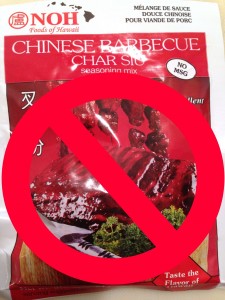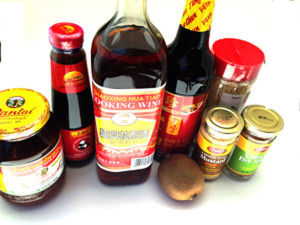 Making authentic-tasting Char Siu on a charcoal or gas grill is easy, but you’ll need some special ingredients.
Making authentic-tasting Char Siu on a charcoal or gas grill is easy, but you’ll need some special ingredients.
When we visited Portland’s Chinatown in the 50s and 60s, we always started every dinner with an order of Chinese BBQ pork. Properly enjoyed with some hot Chinese mustard and toasted sesame seeds, Char Siu was always my favorite part of dinner. Decades later, I can still taste that barbecued pork.
That’s both fortunate and frustrating, because it is practically impossible to find any Char Siu approaching that quality today in my home base of Sacramento. Buffet heat lamps and Red Dye #5 have become unwelcome additions to this ancient recipe.
The reddish tint in a well done Char Siu isn’t from red dye, nor is it from barbecuing, because Chinese pork isn’t barbecued, nor is it properly soaked in food dye. The combination of ingredients, most of which are unique to Chinese cooking and not familiar to many of us, cause this reaction, manifested in taste, texture and color.
Having first experimented with pork belly when making bacon, I started craving authentic Char Siu. Most dishes called Char Siu today are simply pork belly treated with a paste loaded with red dye, or from the contents of a package that looks like this:

Further, some of the folks at my local Asian Mart were asking me why I was going to all the trouble to buy all the ingredients below, when I could just do what is tantamount to a shake ‘n bake with the above, which I learned is what most Chinese restaurants do today. I bought a package to study the ingredients, but I knew it wasn’t the real thing.
After pouring over numerous recipes, I chose one that had great reviews, and seemed authentic. It’s from New York Chef Mark Matsumoto. Although I changed it up a bit and prepared it differently, Chef Mark’s original recipe and article can be found here.
The only significant difference in my recipe is the addition of curing salt, Prague Powder #1. I wanted to ensure a great visual outcome, and the pink salt enhances the flavor and extends the product life. A major departure, however, was preparation was on an outdoor grill, not in an oven.
Char Siu Ingredients and Recipe
One pound of pork belly, trimmed of the rind.
I have exhaustively covered selecting, buying, and trimming pork belly in my article on how to make bacon. If you haven’t worked with pork belly, I think you’ll find this a good read.
Char Siu Marinade
1/2 teaspoon 5 spice powder
2 tablespoons maltose (or honey)
I used honey
2 tablespoons Shaoxing cooking wine (or sherry)
Substitute Mirin if you can’t find Shaoxing
1 tablespoon hoisin sauce
1 tablespoon Thai chili sauce
1 tablespoon Chinese dark soy sauce
Chef Mark commented that this ingredient is very important, as the traditional Japanese (like Kikkomans) soy sauce is much thinner. I prefer Chinese or Hawaiian soy sauce always in cooking anyway, and substituting Japanese soy sauce will affect the taste and is not recommended.
1 tablespoon kiwi, pureed
2 teaspoons oyster sauce
2 cloves garlic, grated
1/4 tsp Prague Powder #1
The USDA formula is 1/4 teaspoon per pound of meat. Do NOT exceed this amount. Prague Powder contains sodium nitrite which is lethal in large quantities. This amount is very safe.
Mix the marinade ingredients together in a mixing bowl.You don’t need to boil it–they mix nicely as is. Place the pork belly in a plastic Ziplock bag. pour in the marinade, and push out as much air as possible so the meat is completely covered by the marinade.
Refrigerate in a dish or tray, so if the bag leaks the marinade will not contaminate other foods, for 72 hours, give or take a few hours depending on your schedule. Each day, turn the bag over, massaging the pork to help the marinade penetrate. When the pork feels quite firm to the touch, and if 72 hours have passed, it’s cured and ready. If not, give it another day and check again.
Don’t let it go much longer than four days. I was curing bacon at the same time which takes 7 days, and let the Char Siu go for the same time. A slight aftertaste told me I had let it cure a little too long–the acids from the ingredients had been working overtime.
Preparing the Char Siu for Cooking
Remove the pork from the bag. Do not rinse, just set aside. Pour the marinade into a pan, and bring to a rolling boil. Let it boil for not less than one minute, nor longer than two minutes. Chef Mark omitted this crucial step; I’m sure it was an oversight. NEVER use marinade that has had contact with uncooked meat without boiling first.
The original recipe calls for baking the pork in a pre-heated, 275 degree oven for an hour, or until the internal temperature of the pork reaches 160°F, then broiling while basting with the marinade until a char forms on top, then turning the pork over, and repeating the basting until that side shows some char. He recommends serving with rice or noodles.
Cooking Char Siu on a Charcoal or Gas Grill
I always prefer outside cooking, and wanted to add a slight charcoal flavor to the Char Siu. I set up my Weber Performer with a good supply of charcoal, and waited until the temperature was between 275°F and 300°F. A gas grill will work fine, adding some wood chips or chunks.
Place the pork as far away from the fire as possible, using the indirect cooking method. Add two chunks of a light wood for some smoke; apple is a good choice. I used alder which is also light, with a pleasant aroma. Use no more than 4 oz. of wood, and don’t use a strong wood such as hickory, oak, or mesquite.
Be sure to keep the grill temperature between 275° and 300°F, and check the internal temperature every 10 minutes or so after the first 30 minutes. Pork is now deemed safe to eat at 145°F, however I’d recommend letting it reach 150° internal temperature. It should take from 1-1.5 hours.
Now, brush on some marinade, turn the pork over so the brushed side is facing the grill, and place directly over the coals. Brush the top side, and check for a nice char on the bottom side by gently lifting the pork with tongs, brushing on marinade each time. Once you see a good char forming, turn the pork over, basting as needed, until both sides are slightly charred.
Double wrap the pork in foil, and let it cool for 30 minutes. Divide your Char Siu into several portions with a sharp knife. By using the curing salt, it will last up to 7 days refrigerated, and for several months vacuum sealed and frozen. Slices should be thin for serving, as shown in the picture.
Char Siu pairs well with a good lager ale. It can be served as an appetizer, with Chinese mustard and toasted sesame seeds as in the first picture, or over noodles or rice as Chef Mark recommends. You can also serve it chilled.
Making authentic Char Siu does take some prep work, and for me a lot of that was finding the ingredients in our huge Asian  market. Don’t even think of trying your local Safeway; they won’t have most of the ingredients. Some have no English to identify them, so if you can’t read the label, take a look at the picture to the right, or ask someone at your local Asian store for help. I leaned on a couple of friendly customers who enjoyed walking around with me looking for just the right brands.
market. Don’t even think of trying your local Safeway; they won’t have most of the ingredients. Some have no English to identify them, so if you can’t read the label, take a look at the picture to the right, or ask someone at your local Asian store for help. I leaned on a couple of friendly customers who enjoyed walking around with me looking for just the right brands.
My Char Siu almost measured up to the great barbecue pork we had as kids in Portland. It was certainly better than anything I’ve ever had since then.
Have fun with this! Let us know how you did in the comments below, and what modifications, if any, you made.

Matt, thanks, love the benefit of local knowledge!
If you’re still in Sacramento the best char siu is found at a store called HO-CHIN. I was born and raised in Sacramento and this was the only place that anyone in my entire family would buy char siu for anything. I believe it’s on Freeport Blvd or fruitridge road south of Sacramento city college
Erik thanks for the question, sorry for the delay. The Prague Powder is for curing. You can delete it if you’re totally against sodium nitrite, but it will not taste the same and you probably won’t like it.
What’s the reason you added the Prague powder? Is it necessary?
Absolutely. I’m definitely going to make another batch and let it go the 4 days. There was a lot of flavor on the surface, but it didn’t have a chance to really penetrate like a good char siu would. But that was within my expectations, so all good there.
Glad you know you’re another bacon-ator…. been curing my own for several years now.
I wonder, back on the char siu…. what the effect would be to get it started in a marinade, then vacuum seal the bag and freeze for later date. I know in some cases, vacuum sealing can seriously accelerate/amp up the marinade’s effectiveness. I suppose one batch can go down for a test…. sort of taking one for the team and all that. When I do it, I’ll post the results.
Hey Jeff, thanks for the great report! Subs that work are very important to post, as we can all learn from another’s success. So glad you enjoyed the Char Siu–better than most Chinese restaurants isn’t it?
I’m not sure how long this article has been up, but I made this today, and it was totally worth the effort.
I didn’t have days to marinade the meat, so I compromised and vacuum sealed it for about 6 hours. I used 1/4 to 3/8″ thick pork steaks that I cut into about 1″ wide strips. The only subs I made to the recipe were I used seasoned rice vinegar instead of the cooking wine, just because that was what I had, and I didn’t use the kiwi. I bet the kiwi would add to the flavor, I just didn’t have one handy and didn’t want to go get one.
Cooked off in the oven on a baking sheet at about 275 until just done, then under the broiler for a few minutes on each side.
Family of 4 demolished the entire sheet.
Thanks for posting this…. as my kids say, this one goes “on the menu”.